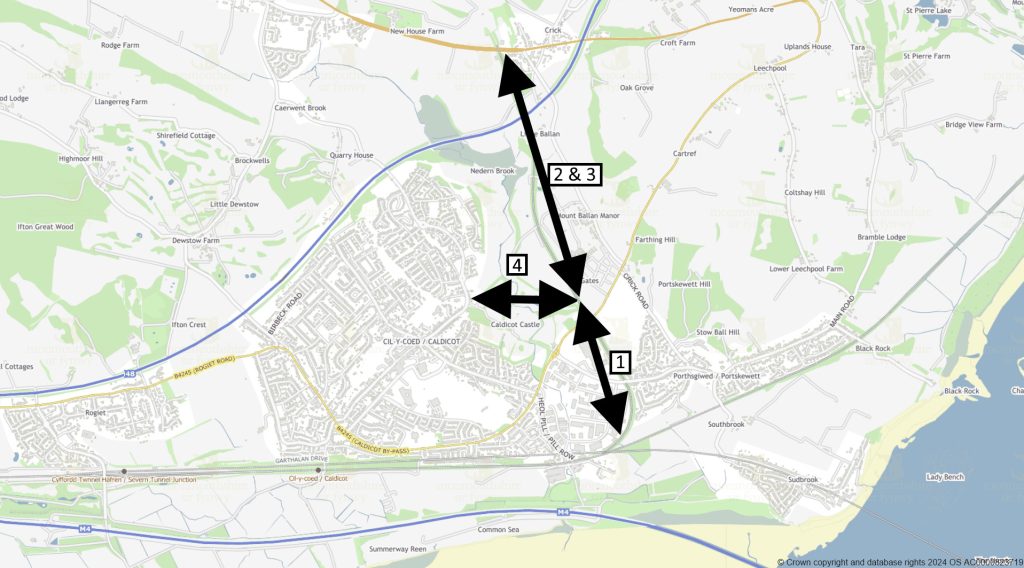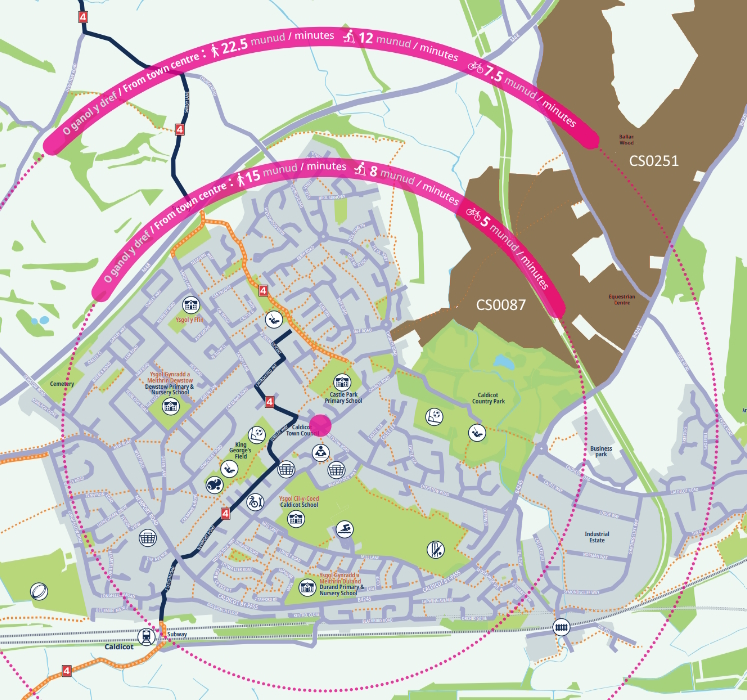Caldicot Active Travel Links and Multi-User Route – Q&A
The Caldicot Links active travel scheme is designed to create an integrated network of shared use routes, linking existing and planned residential areas around east Caldicot to local destinations and public transport. The aim is to enable residents to use active travel for local trips and to connect to the wider Severnside active travel and public transport networks, through the construction of high quality and accessible routes for walking, wheeling and cycling.
Caldicot Active Travel Links scheme

Caldicot Links scheme focuses on the north and east of Caldicot. The scheme is broken down in to three different sections* (see plan below):
- Phase 1: Running along the route of the old ex-Ministry of Defence Dinham railway line, from just south of the Cornfield at Portskewett, to level with Caldicot Castle Country Park.
- Phases 2 & 3: From level with the country park northwards to Crick, crossing the northeast Caldicot development sites which are shown below in brown. The indicated development sites include areas that will be kept as green spaces and will not be built up.
- Phase 4, the Multi-User Route: Running through the Country Park connecting Church Road to the west with Phases 1, 2 and 3 and Caldicot Road to the east.
*Sections of the scheme are being brought forward as funding and other constraints permit, i.e. not necessarily in numerical order.
Phase 1: The 1km long section along the old railway is currently in construction with contractors Horan Construction Limited. This work, is due to be completed in June 2024, finishing with the reinstatement of the temporary construction compound in Caldicot Castle Country Park.
During construction this section of the old railway line will need to be closed to the public for health and safety reasons and will include a temporary closure of the narrow footpath at the south-western end that links through to the industrial estate (Public Right of Way numbered 354/12/1 (part), 354/13/1, 376/10/7, 376/10/6 (part)).
In preparation for construction, vegetation clearance works have already been undertaken during an ecological window to clear areas for three access ramps and the main route. Additionally, many ash trees were felled as they had been identified as posing a risk to path users and to the existing highway bridges, largely due to infection with ash dieback disease, which left the trees at considerable risk of structural failure. An extensive compensatory replanting scheme of native trees and shrubs will be implemented once all the construction works are completed, to provide biodiversity net benefit and lead to a more resilient tree canopy along the route for the future.
At the beginning of December, a community litter pick was held along this section of the Links, when 17 volunteers helped to fill 50 rubbish sacks and create several piles of larger rubbish with items discarded over several decades.
Phases 2 & 3: MCC appointed contractors, Atkins Réalis, are undertaking a study of the options available for developing the route north and east of the Country Park, considering all the opportunities and the constraints of this area.
Phase 4 – Multi-User Route: MCC appointed consultants, Sustrans, have been undertaking a Route Options Review with key stakeholders following initial feedback on route proposals through the country park. Once this is complete, MCC will be ready to start the full design and permission process for the preferred route over the coming year.
Why focus on north and east Caldicot?
This scheme looks to improve sustainable access to services, shops, and sites of education and employment around Caldicot. Trip generation related to the planned residential development to the east and north of Caldicot, as well as the need to mitigate congestion related to local employment sites and the newly toll-free Severn bridges gives extra impetus to the scheme, as this is an opportunity to make active travel the preferred mode for local trips for old and new residents alike.
The phased Caldicot Links scheme focuses on the east of Caldicot, including linking to housing developments off Church Road and Crick Road, to ensure that current and future residents have accessible, healthy and sustainable transport options, to minimise and manage the road traffic impact of a growing population and to direct residents and visitors into the town centre as a local destination.
Below is a detail of our Active Travel Map for Caldicot, showing the time it would typically take to travel in the local area. The local development areas, shown in brown, will include parcels of green space (i.e. the indicated sites include areas that will not be built up):

What is active travel?
Active travel is a term used to describe walking, wheeling or cycling to a destination, which the Active Travel Act (Wales) 2013 calls “purposeful journeys”. It does not cover trips taken purely for leisure although it could significantly enhance leisure activities by helping to link up networks. Active travel can be used to get to school, work, services and shops, or as one of several modes on a longer journey – for example, walking to the station to catch a bus or train. Monmouthshire County Council (MCC)’s active travel strategy focuses on journeys of three miles or less, which means improving walking and cycling infrastructure within communities and between close-by settlements such as Caldicot, Portskewett and Crick, so that active travel can be the natural choice for local journeys. MCC also aims to improve active travel links to public transport, to support sustainable travel across the county.
How is the Caldicot Links scheme funded?
The Caldicot Active Travel links and Multi-user route will be funded through Welsh Government grants aimed at improvements to sustainable transport modes.
How will the removal of trees along active travel path route be mitigated?
In the construction of Phase 1, trees and greenery has been cleared to make way for the path and its access ramps. The amount of clearance is only that which is required to ensure the old railway line is safe for current users and to enable the construction of the Active Travel route while safeguarding wildlife on site. Once construction is complete, compensation planting of native trees and shrubs will introduce a more varied and resilient tree canopy bringing a net benefit for local biodiversity after the intervention.
The improved active travel routes are expected to increase local walking, wheeling and cycling opportunities, which should have a long-term positive impact on the environment and local biodiversity as described by Welsh Government’s Active Travel Act Guidance.
Why can’t cyclists use the road?
Many short car trips could be made by active travel instead. Perceived danger from road traffic is a key barrier preventing more people taking up active travel, and low levels of cycling despite the comprehensive road network demonstrate that cycling in the road is not a practical option for many. This scheme takes the opportunity to improve the accessibility of off-road routes which are more likely to offer an attractive and safe alternative to driving for a broader range of people, building the appetite for active travel whilst cutting the number of short trips made by car.
Contact us
If you would like to contact the project team, please email ActiveTravel@monmouthshire.go
This post is also available in: Welsh
